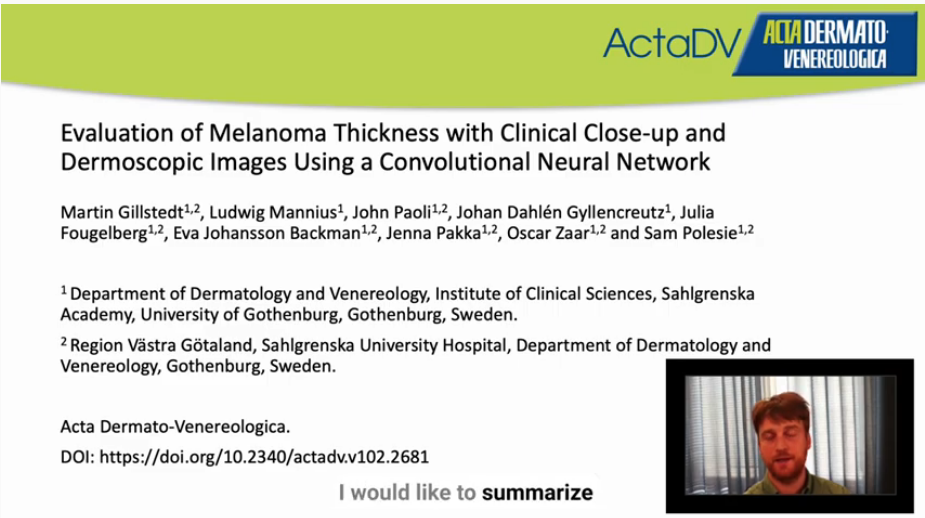Evaluation of Melanoma Thickness with Clinical Close-up and Dermoscopic Images Using a Convolutional Neural Network
DOI:
https://doi.org/10.2340/actadv.v102.2681Keywords:
artificial intelligence, clinical decision-making, melanoma, neural networks, computer, supervised machine learningAbstract
Convolutional neural networks (CNNs) have shown promise in discriminating between invasive and in situ melanomas. The aim of this study was to analyse how a CNN model, integrating both clinical close-up and dermoscopic images, performed compared with 6 independent dermatologists. The secondary aim was to address which clinical and dermoscopic features dermatologists found to be suggestive of invasive and in situ melanomas, respectively. A retrospective investigation was conducted including 1,578 cases of paired images of invasive (n = 728, 46.1%) and in situ melanomas (n = 850, 53.9%). All images were obtained from the Department of Dermatology and Venereology at Sahlgrenska University Hospital and were randomized to a training set (n = 1,078), a validation set (n = 200) and a test set (n = 300). The area under the receiver operating characteristics curve (AUC) among the dermatologists ranged from 0.75 (95% confidence interval 0.70–0.81) to 0.80 (95% confidence interval 0.75–0.85). The combined dermatologists’ AUC was 0.80 (95% confidence interval 0.77–0.86), which was significantly higher than the CNN model (0.73, 95% confidence interval 0.67–0.78, p = 0.001). Three of the dermatologists significantly outperformed the CNN. Shiny white lines, atypical blue-white structures and polymorphous vessels displayed a moderate interobserver agreement, and these features also correlated with invasive melanoma. Prospective trials are needed to address the clinical usefulness of CNN models in this setting.
Downloads
References
Kovarik C, Lee I, Ko J, Ad Hoc Task force on augmented I. Commentary: position statement on augmented intelligence (AuI). J Am Acad Dermatol 2019; 81: 998-1000.
https://doi.org/10.1016/j.jaad.2019.06.032 DOI: https://doi.org/10.1016/j.jaad.2019.06.032
Polesie S, McKee PH, Gardner JM, Gillstedt M, Siarov J, Neittaanmaki N, et al. Attitudes toward artificial intelligence within dermatopathology: an international online survey. Front Med (Lausanne) 2020; 7: 591952.
https://doi.org/10.3389/fmed.2020.591952 DOI: https://doi.org/10.3389/fmed.2020.591952
Polesie S, Gillstedt M, Kittler H, Lallas A, Tschandl P, Zalaudek I, et al. Attitudes towards artificial intelligence within dermatology: an international online survey. Br J Dermatol 2020; 183: 159-161.
https://doi.org/10.1111/bjd.18875 DOI: https://doi.org/10.1111/bjd.18875
Emanuel EJ, Wachter RM. Artificial intelligence in health care: will the value match the hype? Jama 2019; 321: 2281-2282.
https://doi.org/10.1001/jama.2019.4914 DOI: https://doi.org/10.1001/jama.2019.4914
Janda M, Soyer HP. Can clinical decision making be enhanced by artificial intelligence? Br J Dermatol 2019; 180: 247-248.
https://doi.org/10.1111/bjd.17110 DOI: https://doi.org/10.1111/bjd.17110
Polesie S, Jergeus E, Gillstedt M, Ceder H, Dahlen Gyllencreutz J, Fougelberg J, et al. Can dermoscopy be used to predict if a melanoma is in situ or invasive? Dermatol Pract Concept 2021; 11: e2021079.
https://doi.org/10.5826/dpc.1103a79 DOI: https://doi.org/10.5826/dpc.1103a79
Polesie S, Gillstedt M, Kittler H, Rinner C, Tschandl P, Paoli J. Assessment of melanoma thickness based on dermoscopy images: an open, web-based, international, diagnostic study. J Eur Acad Dermatol Venereol 2022 Jul 16. [Online ahead of print].
https://doi.org/10.1111/jdv.18436 DOI: https://doi.org/10.1111/jdv.18436
Polesie S, Sundback L, Gillstedt M, Ceder H, Dahlen Gyllencreutz J, Fougelberg J, et al. Interobserver agreement on dermoscopic features and their associations with in situ and invasive cutaneous melanomas. Acta Derm Venereol 2021; 101: adv00570.
https://doi.org/10.2340/actadv.v101.281 DOI: https://doi.org/10.2340/actadv.v101.281
Gillstedt M, Hedlund E, Paoli J, Polesie S. Discrimination between invasive and in situ melanomas using a convolutional neural network. J Am Acad Dermatol 2022; 86: 647-649.
https://doi.org/10.1016/j.jaad.2021.02.012 DOI: https://doi.org/10.1016/j.jaad.2021.02.012
Polesie S, Gillstedt M, Ahlgren G, Ceder H, Dahlen Gyllencreutz J, Fougelberg J, et al. Discrimination between invasive and in situ melanomas using clinical close-up images and a de novo convolutional neural network. Front Med (Lausanne) 2021; 8: 723914.
https://doi.org/10.3389/fmed.2021.723914 DOI: https://doi.org/10.3389/fmed.2021.723914
Fleiss JL. Measuring nominal scale agreement among many raters. Psychol Bull 1971; 76: 378.
https://doi.org/10.1037/h0031619 DOI: https://doi.org/10.1037/h0031619
Landis JR, Koch GG. The measurement of observer agreement for categorical data. Biometrics 1977; 33: 159-174.
https://doi.org/10.2307/2529310 DOI: https://doi.org/10.2307/2529310
Tschandl P, Rosendahl C, Akay BN, Argenziano G, Blum A, Braun RP, et al. Expert-level diagnosis of nonpigmented skin cancer by combined convolutional neural networks. JAMA Dermatol 2019; 155: 58-65.
https://doi.org/10.1001/jamadermatol.2018.4378 DOI: https://doi.org/10.1001/jamadermatol.2018.4378
Lallas A, Kyrgidis A, Koga H, Moscarella E, Tschandl P, Apalla Z, et al. The BRAAFF checklist: a new dermoscopic algorithm for diagnosing acral melanoma. Br J Dermatol 2015; 173: 1041-1049.
https://doi.org/10.1111/bjd.14045 DOI: https://doi.org/10.1111/bjd.14045

Downloads
Additional Files
Published
How to Cite
Issue
Section
Categories
License
Copyright (c) 2022 Martin Gillstedt, Ludwig Mannius, John Paoli, Johan Dahlén Gyllencreutz, Julia Fougelberg, Eva Johansson Backman, Jenna Pakka, Oscar Zaar, Sam Polesie

This work is licensed under a Creative Commons Attribution-NonCommercial 4.0 International License.
All digitalized ActaDV contents is available freely online. The Society for Publication of Acta Dermato-Venereologica owns the copyright for all material published until volume 88 (2008) and as from volume 89 (2009) the journal has been published fully Open Access, meaning the authors retain copyright to their work.
Unless otherwise specified, all Open Access articles are published under CC-BY-NC licences, allowing third parties to copy and redistribute the material in any medium or format and to remix, transform, and build upon the material for non-commercial purposes, provided proper attribution to the original work.






